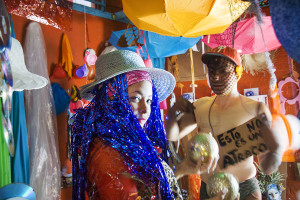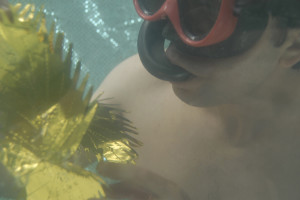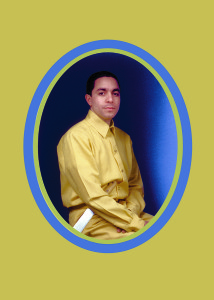A Conversation with Nicolás Dumit Estévez
A Conversation with Nicolás Dumit Estévez
I first came across Nicolás Dumit Estévez’s work when his wily performance Super Merengue (2000) caught my eye. Wearing a super-hero suit and cape and decidedly antiheroic flip flops (chancletas) while handing out bananas to his US audience, Estévez’s iconic Super Merengue offered a humorous sendup of common tropes of Dominican (and Caribbean) identity and masculinity as well as of US tropicalizing perceptions of the Caribbean and its diasporas. This piece is indicative of how Estévez—born in the Dominican Republic and performatively baptized as a Bronxite, a citizen of the Bronx, in 2011—has developed a performative oeuvre that imaginatively engages the different locales he transverses and that embraces audience interactions that foreground the playful and collaborative, rather than the abrasive modality of some notable performance artists. This combination of a deep engagement with specific locales—whether this is the Bronx or Santiago in the Dominican Republic—with a decidedly transnational sensibility, and the merging of his works’ strong critical impulses with gestures of openness and whimsy make Estévez one of the most surprising and significant Dominican artists currently working in the United States.
Estévez received an MFA from Tyler School of Art, Temple University, Philadelphia, and an MA from Union Theological Seminary in the City of New York. He has exhibited and performed at the IX Havana Biennial, PERFORMA, MoMA, Longwood Art Gallery/Bronx Council on the Arts and El Museo del Barrio, among many others. For the past seven years Estévez has been mentored by renowned performance artist Linda Mary Montano, and they have collaborated on several performances. He has completed residencies at PS 1/MoMA, Yaddo and the MacDowell Colony and has received grants from Art Matters, Lambent Foundation, National Association of Latino Arts and Culture, Printed Matter, and Puffin Foundation. He has published Pleased to Meet You: Álbum de fotos de Calaf (IDENSITAT, 2007), Life as Material for Art and Vice Versa (editor; Queens Museum of Art, 2011) and For Art’s Sake (Center for Book Arts, 2006). He teaches at Transart Institute, Berlin-New York. This interview took place via e-mail in Fall 2014.
Maja Horn: Is a notion of a regional Caribbean important to your self-identification? How does this extend, if at all, to a consideration of the Caribbean diaspora?
Nicolás Dumit Estévez: This is a question that keeps surfacing more and more for me, as I continue to push my identities to exist in an ongoing state of flux. I would say that, performatively speaking, it was not until 1999 that I became invested in making visible my passage from Lebanese Dominican to Dominican York and then to Bronxite. There are, of course, nuances informing and complicating each of these categories. An example of this is my search for any connections that I, or my Dominican and Lebanese Dominican family, may have to the neighboring republic of Haiti. Similarly, I have come to the realization that I cannot be a Bronxite without also being Puerto Rican Nuyorican Boricua. All in all, and while involved in the act of collapsing, reshaping, and combining notions of being-hood, I have been confronted with the fact that there is a steady constant in the midst of this push and pull: my caribeñidad.
It has become clear to me that the Caribbean as a mental-spiritual-physical locus is the fiery cauldron out of which everything that I was, am, and will be grows. This witches’ cauldron, radically speaking, is where my cosmology boils like a thick sancocho. I see this soupy mess as a Big Bang always in the making and never reaching a state of completion. At the end of the day, it may well be that caribeñidad encapsulates any possible identities I may dream of undertaking; I never think of myself in traditional diasporic terms, but more as a two-legged island overlapping/interacting with the geographies I encounter along my path.
MH: You form part of the Dominican diaspora here in New York City. What relation does your work have with your Dominican origins?
NDE: I have been outside the Dominican Republic for almost a quarter of a century, and I do not live in a Dominican neighborhood in New York City. Longwood, the place I call home in the Bronx, is in essence Puerto Rican Nuyorican Boricua. For a while, I was comparing my situation to that of my relatives from Lebanon who relocated to the Dominican Republic. With the passage of time they forgot words in their native tongue, hybridized their diets, and built a home outside their country. However, going back to Santiago in 2013 shifted this pattern for me. The reason for returning to the island was to produce C Room, an eight-hour multidimensional experience part of En Mas’ Carnival and Performance Art of the Caribbean, a project curated by Claire Tancons and Krista Thompson. C Room entailed working in the context of the local carnival. At the end of my stay, as my friend Josué Gómez had suggested, I found a piece of my umbilical cord that remained buried in the Dominican soil. There are still many more pieces of it to be excavated. The carnival provided for me the context for an active enactment of family. More than that, the presentation of C Room at the Museo Folklórico Don Tomás Morel shook some of the identitarian foundation that I had been carefully building abroad, brick by brick. Have I gone full circle in regards to dominicanidad?
C Room, 2014, an eight-hour performance at Museo Folklórico Don Tomás Morel,
Santiago de los Treinta Caballeros, Dominican Republic
Photograph: Raymond Marrero
MH: Many of your performances, including Super Merengue and I Swam with a Mermaid, foreground different forms of male and female embodiment. Do you feel that artistic representation has the potential or responsibility to transgress traditional understandings of gender?
NDE: Yes to both, because much of our day-to-day is dominated by a panoply of dogmatic stances hindering open conversations and experimentation with gender. Why not destabilize these unquestioned preconceptions with arresting images of a noncapitalist and non-market-driven nature?
I believe that in a world of cell phones users, and therefore of millions of imagemakers (selfie-makers)—not only artists but doctors, ministers, grocers, cab drivers, to name a few—should feel the call to produce their own visual counter-responses to the supremacist ideologies that keep us boxed in confining gender categories.
In I Swam with a Mermaid, a performance I developed in 2009, I encountered an aquatic gender-bending being who feeds on algae and boasts an iridescent tail. I realized then that water was the ideal element to talk about transcending traditional notions of maleness and femaleness or for turning them upside down. Gender conferences should take place in the erotic depths of the sea, among the sinuous waves.
I swam with a Mermaid, performance, 2008. Photograph: Sol Aramendi. Image courtesy of Nicolás Dumit Estévez
MH: I am interested in particular in how you represent masculinity. How do you feel your work (in general or one work in particular) represents masculinity? Do you aim to transgress traditional notions of masculinity, and, if so, how is your brand of performance particularly well suited for this?
NDE: My work seeks to shatter representations of “maleness” that are often taken for granted. And because I work performatively, I usually delve into the autobiographical. The masculinities that I address in my art and life experiences are therefore specific to my upbringing in the Dominican Republic and to my relocation to the United States. Any discussion about them exists at the intersection of race and nationality because whiteness can render all “others,” whether men or women, as “female.”
I once presented a performance with the Queens Museum for which I embodied Chiquito Elenano, the male counterpart of Chiquita Banana. In his role as the host of a comprehensive presentation on the plantain, Chiquito Elenano sold this staple for one US American dollar. Each plantain came with a green card with a recipe printed on it. On another occasion, I produced a series of love letters, formatted as an artist book, to one of my three dentists. These letters evolved out of a solo performance titled Cavum Gloriosum, which focused on an examination of the organ of the mouth. I use play and humor to navigate gender in a fluid way, turning plantains into foreign penises, mouths into erotic orifices visible to all, and dentistry into a sadomasochist engagement, in which pleasure and discomfort can overlap.
I can’t think of another channel other than the performative to bring actions like Cavum Gloriosum or I Swam with a Mermaid, among many others, to fruition. Aren’t we constantly performing gender and sexuality in ways that reference the theatrical?
USA Paradisiaca, 2001, performance/mixed media, various dimensions © 2001 Nicolás Dumit Estévez
MH: Whom do you envision as your primary audience for your work? In terms of reception, has that audience been different from the one you envisioned? How much do you feel needs to be “explained” to audiences, and is it important for you to contextualize your work?
NDE: I feel that I have been losing my audiences in the act of democratizing my work. It all started as I pushed my practice to exist at the interstice between art and the day-to-day. Conversely, this situation has triggered my interest in doing away with having to call my “pieces” performances and in inviting would-be audiences to become participants and collaborators instead of voyeurs.
On many occasions I have asked curators or art administrators to become performers, as has been the case with Alanna Lockward, who collaborated in an art and life experience in Berlin and Prague dealing with my embodiment of the Holy Infant of Prague and Vice Versa. In other occasion, I proposed that William Aguado and Susan Newmark Fleminger baptize me as a Bronxite, a citizen of the Bronx. Edwin Ramoran once narrated my path through the arts in the middle of a Quinceañera ceremony I organized. Edwin and I pinned résumé corsages on people’s lapels and danced to Johann Strauss II’s The Blue Danube!
In September 2014 I convoked a small group to come to the Floating Library, a project by Beatrice Glow, to join in Talking Life and Art while Applying Eye Shadow and Spreading PB&J on Bread. This I conceived as an improvisational encounter that approached art as part of a larger experience called life. The event was meant to develop into an embodied conversation of a collaborative nature involving all of those attending. The outcome, if any, of this gathering was meant to be shaped in situ by the participants’ stories, intellectual contributions, bodily movements, and performative gestures. Talking Life and Art while Applying Eye Shadow and Spreading PB&J on Bread sought to break away from binaries such as art/life and audience/performer, among others, while offering participants the opportunity to open themselves up to that which does not care to be defined or categorized.
Next time I want people to join me in Putting Baby Powder on One’s Face while Drawing Celestial Bodies and Eating Cucumbers. I have already proposed this to an arts organization in New York City, and I am curious as to whether this organization will bite the apple or not.
Going back to one of your questions, I would prefer to explain my work less and less and let the miraculous that may surface through it be experienced. There is so much over intellectualization of performance art.
MH: Your works walk the fine line between an exploration of the body’s potential and the danger of exploiting the body. How does this distinction function for you (if at all)? How do you maintain the integrity of your work while also respecting those you represent?
NDE: At an early stage of my path through the arts I understood the great responsibility those who work mining or dismantling stereotypes have. Many white art-educated audiences have learned how to respond to performance art and to political or pseudo-political artwork that critiques privilege. I feel more comfortable if, instead of having people laugh at me, we can all laugh with each other.
With my work involving groups and communities, I try to remain alert so as not to speak for anyone other than myself and as to how the images of any given experience are used. Art (with capital A) has the tendency to capitalize on anything that can generate a profit in the market, including images of others. First and foremost, I see myself as a person, then as an artist. This helps keep things in perspective.
I am drawn to your use of the words exploration and exploitation in connection to the body because any performative exploration of one’s body can certainly have an explosive outcome.
Maja Horn is an associate professor of Spanish and Latin American cultures at Barnard College, New York. She is the author of Masculinity after Trujillo: The Politics of Gender in Dominican Literature (University Press of Florida, 2014) and writes and teaches about contemporary Caribbean literature, visual arts, and performance.


